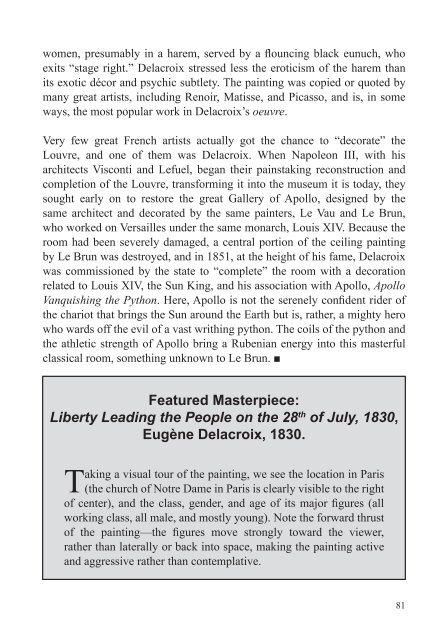You also want an ePaper? Increase the reach of your titles
YUMPU automatically turns print PDFs into web optimized ePapers that Google loves.
women, presumably in a harem, served by a � ouncing black eunuch, who<br />
exits “stage right.” Delacroix stressed less the eroticism of the harem than<br />
its exotic décor and psychic subtlety. <strong>The</strong> painting was copied or quoted by<br />
many great artists, including Renoir, Matisse, and Picasso, and is, in some<br />
ways, the most popular work in Delacroix’s oeuvre.<br />
Very few great French artists actually got the chance to “decorate” the<br />
<strong>Louvre</strong>, and one of them was Delacroix. When Napoleon III, with his<br />
architects Visconti and Lefuel, began their painstaking reconstruction and<br />
completion of the <strong>Louvre</strong>, transforming it into the museum it is today, they<br />
sought early on to restore the great Gallery of Apollo, designed by the<br />
same architect and decorated by the same painters, Le Vau and Le Brun,<br />
who worked on Versailles under the same monarch, Louis XIV. Because the<br />
room had been severely damaged, a central portion of the ceiling painting<br />
by Le Brun was destroyed, and in 1851, at the height of his fame, Delacroix<br />
was commissioned by the state to “complete” the room with a decoration<br />
related to Louis XIV, the Sun King, and his association with Apollo, Apollo<br />
Vanquishing the Python. Here, Apollo is not the serenely con� dent rider of<br />
the chariot that brings the Sun around the Earth but is, rather, a mighty hero<br />
who wards off the evil of a vast writhing python. <strong>The</strong> coils of the python and<br />
the athletic strength of Apollo bring a Rubenian energy into this masterful<br />
classical room, something unknown to Le Brun. �<br />
Featured Masterpiece:<br />
Liberty Leading the People on the 28 th of July, 1830,<br />
Eugène Delacroix, 1830.<br />
T aking a visual tour of the painting, we see the location in Paris<br />
(the church of Notre Dame in Paris is clearly visible to the right<br />
of center), and the class, gender, and age of its major � gures (all<br />
working class, all male, and mostly young). Note the forward thrust<br />
of the painting—the � gures move strongly toward the viewer,<br />
rather than laterally or back into space, making the painting active<br />
and aggressive rather than contemplative.<br />
81







